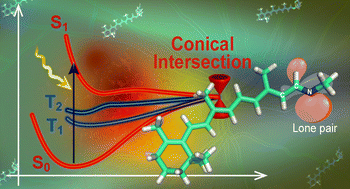The involvement of triplet states in the isomerization of retinaloids†
Abstract
Rhodopsins form a family of photoreceptor proteins which utilize the retinal chromophore for light energy conversion. Upon light absorption the retinal chromophore undergoes a photoisomerization. This reaction involves a non-radiative relaxation through a conical intersection between the singlet excited state and the ground state. In this work we studied the possible involvement of triplet states in the photoisomerization of retinaloids using the extended multistate (XMS) version of CASPT2. To this end, truncated models of three retinaloids were considered: protonated Schiff base, deprotonated Schiff base and the aldehyde form. The optimized geometries of the reactant, the product and the conical intersection were connected by a linear interpolation of internal coordinates to describe the isomerization. The energetic position of the low-lying singlet and triplet states as well as their spin–orbit coupling matrix elements (SOCME) were calculated along the isomerization profile. The SOCME values peaked in vicinity of the conical intersection for all the retinaloids. Furthermore, the magnitude of SOCME is invariant to the number of double bonds in the model. The SOCME for the protonated Schiff base is negligible (1.5 cm−1) which renders the involvement of the triplet state as improbable. However, the largest SOCME value of 30 cm−1 was found for the aldehyde form, followed by 15 cm−1 for the deprotonated Schiff base.

- This article is part of the themed collection: PCCP 2021 Emerging Investigators


 Please wait while we load your content...
Please wait while we load your content...